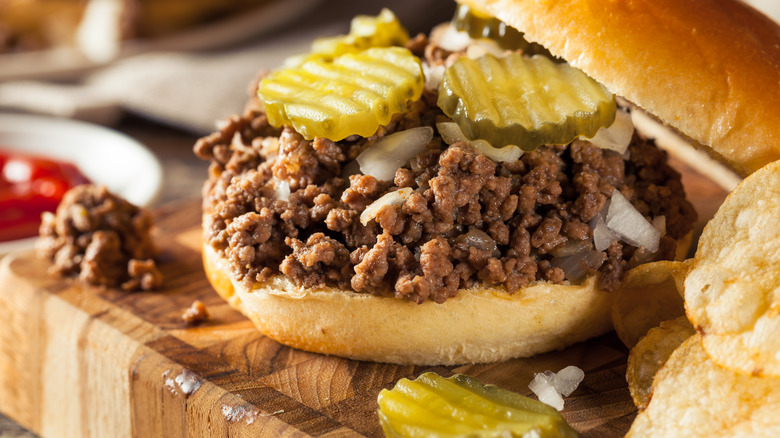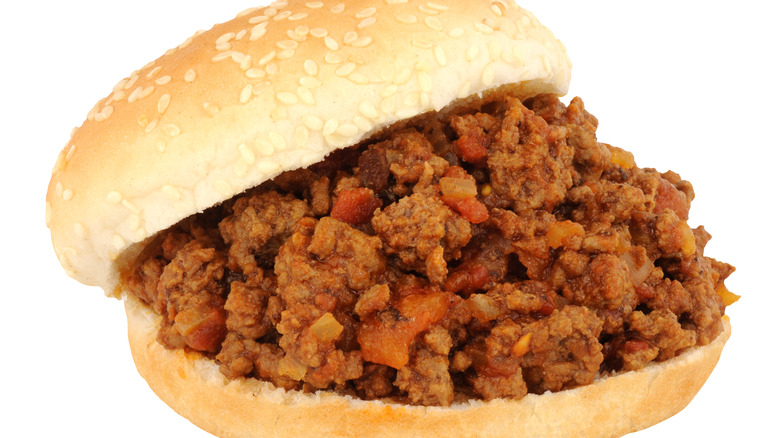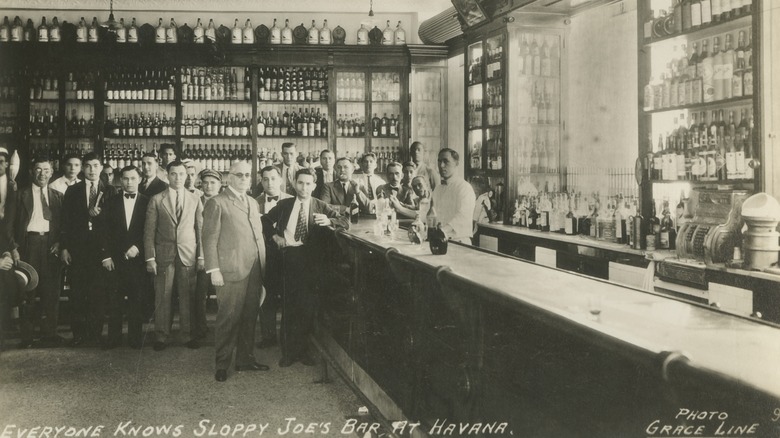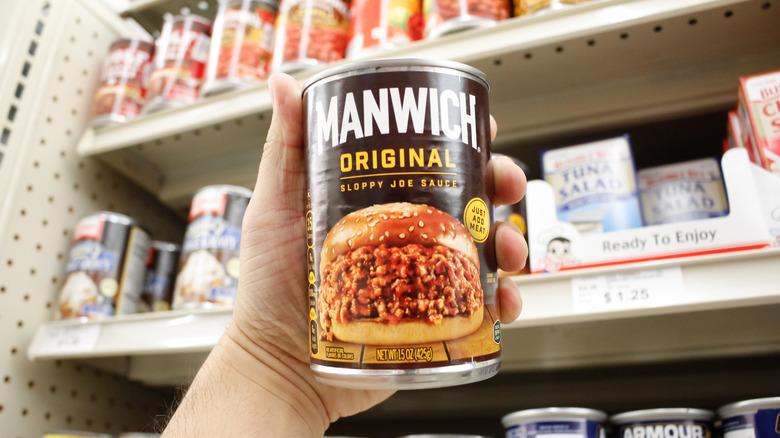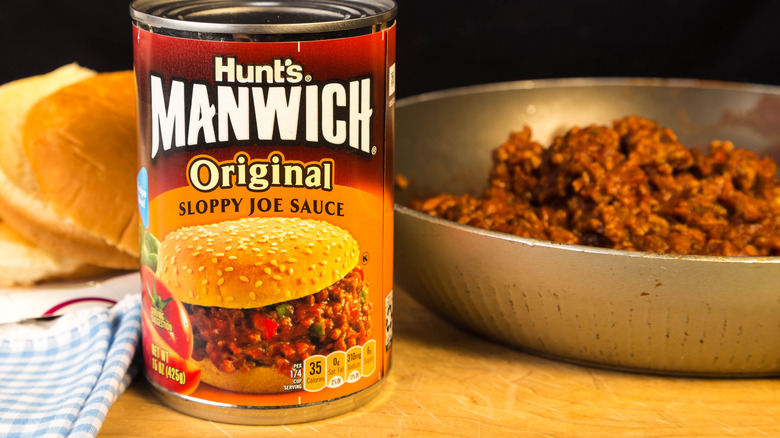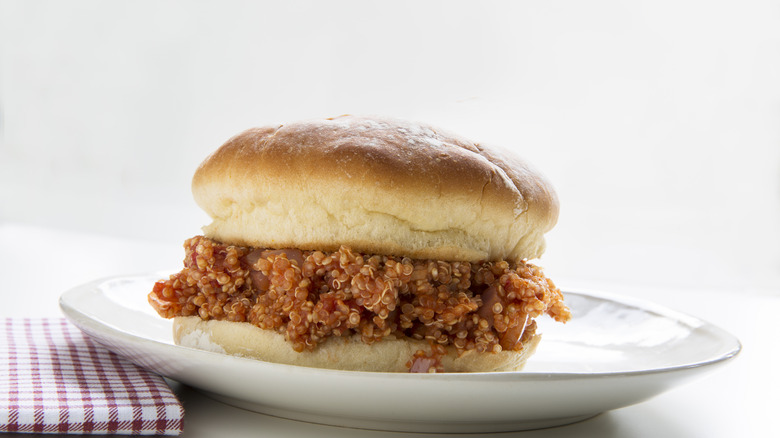The Untold Truth Of Sloppy Joes
A staple of school cafeterias (and of the movies, with memorable cinematic appearances in "Billy Madison," "It's a Wonderful Life," and "Citizen Kane") the sloppy joe is nothing if not a beloved American staple. But did you know that sloppy joes actually have roots in another, less widespread but equally delicious sandwich? Or that there's some consternation over who the actual Joe behind their name really was?
At its core, a sloppy joe, according to our recipe, is a simple combo of seasoned ground beef simmered in a sweet, tomatoey sauce made with ketchup, brown sugar, and various seasonings. It's usually served on a roll (either a simple hamburger bun or a sturdier kaiser roll), and it's a deliciously messy comfort food staple.
But there's loads you probably don't know about this sandwich, ranging from its links to Cuba to Ernest Hemingway's involvement in making it famous. Here's everything you didn't even know you didn't know about this beloved sandwich.
Sloppy joes are similar — but not quite the same — as loose meat
Before there was the sloppy joe, there was the sandwich that (maybe) started it all: the loose meat. With a name even more unappetizing than that of the sloppy joe, the loose meat sandwich is an oft-overlooked specialty from the Midwest that likely kicked off the invention of the sloppy joe, at least according to some sources.
Loose meat is essentially a less-sloppy sloppy joe, according to Culinary Hill. The sandwich combines sautéed or steamed ground beef with a far simpler seasoning of onions, mustard, and pickles — no tomato sauce, no slop. Loose meat sandwiches are specifically an Iowa thing — most famously at the Maid-Rite chain of restaurants. Elsewhere in the state, the sandwich may be known by other names including a loose hamburger sandwich or a Nu-Way.
According to Food & Wine, loose meat sandwiches grew slightly more famous nationwide after appearing as the house special at Roseanne Lanford's Lunch Box on the series "Roseanne." And according to The Takeout, loose meat could be the inspiration — or, at the very least, the jumping-off point — for what would become the sloppy joe.
A real Joe may have invented the sloppy joe in Iowa
By some accounts, the sloppy joe was likely invented in Iowa. According to Wonderopolis, the sandwich may have gotten its start in Sioux City, where a cook named Joe began seasoning the loose meat sandwiches at Floyd Angell's café with tomato sauce, making them sloppier and saucier than ever before. Loose meat had been appearing on Iowa café menus as early as 1924, Chowhound explains, and Angell, who also, the outlet notes, would also create the Maid-Rite sandwich, ostensibly began serving the sloppier versions in the 1930s.
While it's nice to imagine that the cook behind the sandwich was called Joe, the outlet does note the high possibility that an actual Joe never existed. Citing "The Encyclopedia of American Food and Drink," Chowhound notes that the name Joe is often used in America as a generic name for a random everyman, and that there may never have been a real Joe behind sloppy joes at all.
Some claim the sloppy joe was inspired by a Cuban dish
Another origin story for the sloppy joe starts, not in Iowa, but rather in Havana, Cuba, where, according to The Takeout, a man named José Abeal Otero began serving sloppy joes in the late 1910s. The original recipe may have been inspired Cuban ropa vieja or picadillo. In this version of the story, the name of the sandwich, according to Wonderopolis, comes from the fact that Otero's restaurant was often messy or "sloppy." Otero served chilled seafood in addition to sandwiches, and the ice that kept his seafood fresh was forever melting and muddying the restaurant's floor. Patrons nicknamed Otero Sloppy Joe, and his establishment became known as Sloppy Joe's, paving the way for the sandwich to earn the same name.
The original Sloppy Joe's closed down back in 1959, but visitors to Havana these days can visit it once more. The establishment reopened its doors in 2013, after a long and in-depth restoration project of the beautiful original building (via Sloppy Joe's). According to recent visitors on Tripadvisor, the bar still serves the namesake sandwich, with one reviewer who visited in 2018 writing that it was "the best [they] ever had."
Sloppy joes may owe their popularity to Ernest Hemingway
If the Havana origin of sloppy joes is to be believed, then we have one man to thank for their all-American appeal: Ernest Hemingway.
According to The Takeout, Ernest Hemingway was a stalwart regular of Sloppy Joe's, with a hearty appreciation for both the Havana bar and its namesake sandwich. Back in Key West, he convinced his friend, bar owner Joe Russell, to rename his bar from The Silver Slipper to Sloppy Joe's and start serving the sandwich Hemingway remembered from Cuba. The bar's manager told Mashable in 2015 that the sandwich became more Americanized in Key West. They claimed that the Key West version of the sandwich perfected the formula we know and love today.
The Key West Sloppy Joe's remains open today and even hosts an annual Hemingway look-alike contest. Of course, it also maintains the sloppy joe sandwich on the menu. According to Blue Apron, the bar sells more than 50,000 of the sandwiches a year.
Manwich made the sloppy joe easy to recreate at home
However sloppy joes came to be, one thing is for sure: Manwich is responsible for bringing them into many American kitchens.
While recipes for sloppy joes began appearing in American cookbooks beginning in 1949, according to Chowhound, it took this store-bought sauce for them to become a true staple.
Manwich was launched by Hunt Foods, which had been purchased by Norton Simon of Val Vita Food Products in 1943, according to "Food and Drink in American History: A 'Full Course' Encyclopedia." Known at first for ketchup and tomato sauce, Hunt's launched Manwich — its canned sloppy joe sauce — in 1969, according to Foodimentary. Marketed with the slogan "A sandwich is a sandwich, but a Manwich is a meal," it mirrored other convenience foods like Hamburger Helper in appealing to the desire among American home cooks for hearty, nourishing meals that could be made quickly and easily.
Hunt's came under fire for prejudice due to one Manwich ad campaign
While Manwich was exceedingly popular through the latter half of the 20th century, Hunt's did make one tone-deaf misstep in 2011 that risked jeopardizing the popularity of its product. AdWeek explains that in 2011, the brand launched a new ad campaign featuring a trio of ads in which the brand seems to celebrate violence against men who deviate from more "masculine" pursuits. In each of the spots, a man is depicted speaking excitedly about an interest or hobby more typically associated with women: hair, shoes, or musicals. The man in question is then slapped by a phantom hand and told, "It's called a Manwich."
The ad, the outlet explains, was quickly pulled after a petition on Change.org argued that the campaign was promoting violence against gender non-conforming men. While that was clearly not the brand's intent, there's no question that the ad campaign was in poor taste.
Sloppy joes are a school cafeteria lunch staple for a reason
Manwich may have brought the sloppy joe home, but the home kitchen is far from the only place that Americans are likely to encounter them. According to Blue Apron, sloppy joes are very popular in school cafeterias.
"I think the origination of placing sloppy joes on school menus likely came from a need for a fulfilling a hearty meal with a minimal cost," Robert Jaber, Director of Office of Food and Nutrition Services for District of Columbia Public Schools tells the outlet. "The sloppy joe, if served properly, can be the perfect combination of economics, nutrition, heartiness, and student acceptance — it's a perfect fit for a school menu."
And Margo Livingston, Kitchen Manager of Stonepark Intermediate School in Charlottetown, Canada, adds that given the rich flavor profile and innate sauciness of a sloppy joe, it's the ideal vehicle to deliver an extra helping of veggies to picky kids who won't necessarily even notice they're there. Indeed, one writer at Mel Magazine remembers sloppy joes as his favorite school cafeteria meal.
SNL made the sloppy joe even more famous
Sloppy joes' omnipresence on cafeteria tables landed them a much-talked-about cameo on SNL. In the 1994 sketch, Adam Sandler sings a song exploring a story of angry cafeteria food revolting against the lunch lady (played by Chris Farley). It is the sloppy joe sandwich, played by Kevin Nealon, that swoops in to save the day, concluding the spot with a slow dance with Farley's lunch lady, whom, Sandler sings, it will go on to marry and give six children (Yeah, it's weird. And yeah, it's still funny).
In his biography of Sandler entitled "Adam Sandler: America's Comedian," Bill Crawford writes that the song was "Sandler magic at its finest." If you've seen the sketch, it's hard to think about anything else whenever the topic of sloppy joes comes up in conversation. The song includes some sloppy joe slander: Sandler sings "yesterday's meatloaf is today's sloppy joes," insinuating that the sandwich is a way to use up old leftovers.
White Castle offers a range of sloppy joe sliders
Sloppy joes are pretty omnipresent in cafeterias but surprisingly absent from fast food joints. Why wouldn't chains like McDonald's feature them, especially since they already have most of the ingredients on hand already?
There is at least one fast-food chain has capitalized on this popular sandwich: White Castle. Whiter Castle first released sloppy joe slider as a limited-time time in 2020, per QSR. A couple of years later, the chain created a lineup of sloppy joe-themed items for "Joenuary" 2022, according to Thrillist. The options included a spicy joe with smoked jalapeño cheese and jalapeño crisps, a smoky joe with smoked cheddar cheese and crispy onions, and a classic 99-cent sloppy joe slider. You could even get sloppy fries topped with the beefy, tomatoey glop and even sloppier cheese sauce. They got (who else?) Fat Joe to be the celebrity spokesman for the Joenuary menu.
Sloppy joes are popular with celebrities
Since they're childhood favorite of Americans nationwide, it's perhaps no surprise that sloppy joes have their share of celebrity fans, including former New York Giants quarterback Eli Manning, who featured a pic of his double portion of sloppy joes on Twitter. Sloppy joes have also been celebrated by Chef Paul Wahlberg, of burger chain Wahlbergers (co-owned with brothers Mark and Donnie), who shared his recipe for sloppy joes during the pandemic and subsequent lockdowns (via Boston Herald). Food Network star Jeff Mauro shared his healthy sloppy joe recipe that incorporates turkey and grated vegetables on Instagram. Actress Shiri Appleby also shared her sloppy joe recipe, developed with chef husband John Shook, with US Weekly.
These and other stars — as well as regular Americans — can share their love of the sandwich with other sloppy joe fans on March 18, which is National Sloppy Joe Day, according to Foodimentary.
There are some variations on the sloppy joe theme
While a classic sloppy joe is relatively simple, there are loads of variations on the theme. Some are just different names for the same sandwich: The Takeout mentions the Wimpy of northern Pennsylvania, a name that a commenter on Eat at Home Cooks' recipe notes may come from the way the "wimpy" hamburger buns fall apart when topped with so much messy, saucy filling. Chowhound, meanwhile, points to other names like slush burgers or yum yums.
In addition to just using a different name for them, there are also different ways to change up the recipe. Chowhound cites the slightly leaner Sloppy Jane, made with ground turkey instead of ground beef, or the torpedo, which is served on a hoagie instead of a burger bun and features peppers in the sauce. AllRecipes, meanwhile, has recipes for vegetarian versions and even one that's a mashup with Buffalo chicken, while Kristen Carli crafted a grilled cheese sloppy joe for Mashed.

